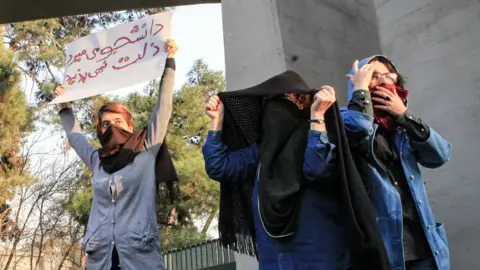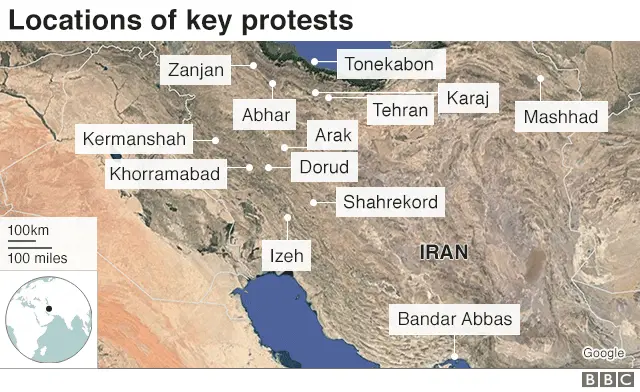Iran protests: Telegram and Instagram restricted
Iran has moved to restrict social media networks that have been used to organise four days of anti-establishment protests.
The "temporary" restrictions on the apps Telegram and Instagram were imposed to "maintain tranquillity", state news agency Irib reports.
The protests have been the biggest show of dissent since huge rallies in 2009.
President Hassan Rouhani has said Iranians have the right to protest, but not cause disorder.
The protests began in the north-east as an outcry against economic hardship and rising prices, but turned political in many places, with slogans chanted against Supreme Leader Ayatollah Ali Khamenei, Mr Rouhani and Iran's interventionist foreign policy in the region.
In his first public comments since the demonstrations broke out, the Iranian president, speaking at a cabinet meeting, said that citizens were "completely free to make criticism and even protests".
But he added that the government would not tolerate any action that created "social disorder", the Iranian Students News Agency reported.
After violence flared in many places on Saturday, it is unclear how many demonstrations are occurring on Sunday. Small crowds have gathered in Tehran and police have used water cannon to disperse protesters at a major intersection - as captured in a video obtained by BBC Persian.
Allow X content?
Why are these social networks being restricted?
In a tightly controlled media environment, much of the information about the demonstrations has emerged via social media, and platforms like Telegram and Instagram have been used extensively by protesters.
Telegram in particular is very popular in Iran, with more than 50% of the country's 80m population said to be active on the app.
The company's CEO Pavel Durov tweeted that Iranian authorities took action after his company refused to shut down "peacefully protesting channels".
Allow X content?
Mr Durov explained in a Telegram post that a major foreign-based opposition channel, Amadnews, was blocked on Saturday by Telegram after it called for violence against police.
He said a new "peaceful channel" - access to which is now being restricted - was set up for hundreds of thousands of their subscribers.
Iranian Communications Minister Mohammad-Javad Azari Jahromi had earlier accused channels like Amadnews of promoting "armed uprising and social unrest", including the use of petrol bombs.
Where will the protests lead?
Analysis by Kasra Naji, BBC Persian
There is widespread and seething discontent in Iran where repression is pervasive and economic hardship is getting worse - one BBC Persian investigation has found that on average Iranians have become 15% poorer in the past 10 years.
Protests have remained confined to relatively small pockets of mostly young male demonstrators who are demanding the overthrow of the clerical regime.
They have spread to small towns throughout the country and have the potential to grow in size.
But there is no obvious leadership. Opposition figures have long been silenced or sent into exile.
Even in exile, there is no one opposition figure that commands a large following. Some protesters have been calling for the return of the monarchy and the former shah's son, Reza Pahlavi, who lives in exile in the United States, has issued a statement supporting the demonstrations. But there are signs that he is as much in the dark about where these protests are going as anyone else.
BBC Persian, which broadcasts on TV, on radio and online from London, is banned in Iran - where staff and their families routinely face harassment and questioning from the authorities.
Has there been violence?
There were outbreaks of clashes in several cities on Saturday and two protesters died of gunshot wounds in the western city of Dorud.
The authorities said security forces did not open fire on demonstrators, and blamed the deaths instead on Sunni Muslim extremists and foreign powers.
Correspondents say the reference to foreign intelligence agencies was intended to mean Saudi Arabia.
Iran's Revolutionary Guards have warned anti-government protesters they will face the nation's "iron fist" if political unrest continues. Scores of people are reported to have been arrested in recent days, including 200 in Tehran on Saturday night.
 EPA
EPAThe Islamic Revolutionary Guards Corps (IRGC) is a powerful force with ties to the country's supreme leader, and is dedicated to preserving the country's Islamic system.
Brig-Gen Esmail Kowsari told the Isna news agency: "If people came into the streets over high prices, they should not have chanted those slogans and burned public property and cars."
Iran's interior minister has also warned the public that protesters will be held accountable.

What has been the response, at home and abroad?
The Iranian authorities are blaming anti-revolutionaries and agents of foreign powers for the outbreak of protests.
But politicians have also weighed in. Reformists tend to stress people's right to freedom of expression, while conservatives highlight economic problems and accuse some of attempting to hijack the protests and divert attention from economic problems to political demands.
The US has led international support for the protesters.
In his latest tweet on the issue, President Donald Trump said that Iranians were "finally getting wise as to how their money and wealth is being stolen and squandered on terrorism".
Iran's foreign ministry called earlier comments from Mr Trump and other US officials "opportunistic and deceitful".
What happened in 2009?
On Saturday, thousands of pro-government demonstrators turned out for pre-arranged rallies across the country to mark the eighth anniversary of the suppression of the 2009 street protests.
Those mass demonstrations - referred to as the Green Movement - were held by millions of opposition supporters against the disputed election victory of incumbent president Mahmoud Ahmadinejad.
At least 30 people were killed and thousands arrested in the wave of protests, which drew the largest crowds on Iran since the Islamic Revolution in 1979.
